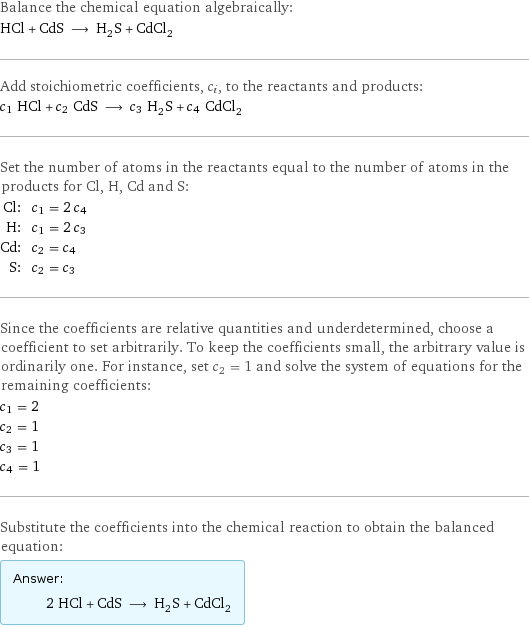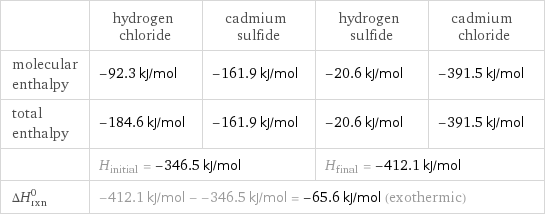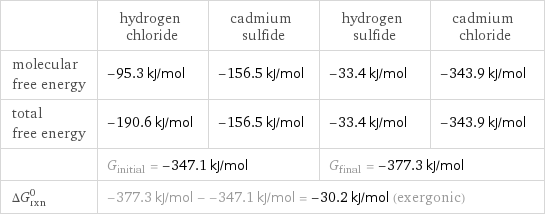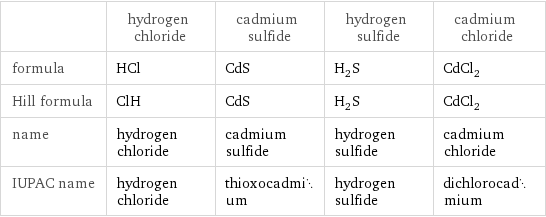Input interpretation

HCl hydrogen chloride + CdS cadmium sulfide ⟶ H_2S hydrogen sulfide + CdCl_2 cadmium chloride
Balanced equation

Balance the chemical equation algebraically: HCl + CdS ⟶ H_2S + CdCl_2 Add stoichiometric coefficients, c_i, to the reactants and products: c_1 HCl + c_2 CdS ⟶ c_3 H_2S + c_4 CdCl_2 Set the number of atoms in the reactants equal to the number of atoms in the products for Cl, H, Cd and S: Cl: | c_1 = 2 c_4 H: | c_1 = 2 c_3 Cd: | c_2 = c_4 S: | c_2 = c_3 Since the coefficients are relative quantities and underdetermined, choose a coefficient to set arbitrarily. To keep the coefficients small, the arbitrary value is ordinarily one. For instance, set c_2 = 1 and solve the system of equations for the remaining coefficients: c_1 = 2 c_2 = 1 c_3 = 1 c_4 = 1 Substitute the coefficients into the chemical reaction to obtain the balanced equation: Answer: | | 2 HCl + CdS ⟶ H_2S + CdCl_2
Structures

+ ⟶ +
Names

hydrogen chloride + cadmium sulfide ⟶ hydrogen sulfide + cadmium chloride
Reaction thermodynamics
Enthalpy

| hydrogen chloride | cadmium sulfide | hydrogen sulfide | cadmium chloride molecular enthalpy | -92.3 kJ/mol | -161.9 kJ/mol | -20.6 kJ/mol | -391.5 kJ/mol total enthalpy | -184.6 kJ/mol | -161.9 kJ/mol | -20.6 kJ/mol | -391.5 kJ/mol | H_initial = -346.5 kJ/mol | | H_final = -412.1 kJ/mol | ΔH_rxn^0 | -412.1 kJ/mol - -346.5 kJ/mol = -65.6 kJ/mol (exothermic) | | |
Gibbs free energy

| hydrogen chloride | cadmium sulfide | hydrogen sulfide | cadmium chloride molecular free energy | -95.3 kJ/mol | -156.5 kJ/mol | -33.4 kJ/mol | -343.9 kJ/mol total free energy | -190.6 kJ/mol | -156.5 kJ/mol | -33.4 kJ/mol | -343.9 kJ/mol | G_initial = -347.1 kJ/mol | | G_final = -377.3 kJ/mol | ΔG_rxn^0 | -377.3 kJ/mol - -347.1 kJ/mol = -30.2 kJ/mol (exergonic) | | |
Equilibrium constant
![Construct the equilibrium constant, K, expression for: HCl + CdS ⟶ H_2S + CdCl_2 Plan: • Balance the chemical equation. • Determine the stoichiometric numbers. • Assemble the activity expression for each chemical species. • Use the activity expressions to build the equilibrium constant expression. Write the balanced chemical equation: 2 HCl + CdS ⟶ H_2S + CdCl_2 Assign stoichiometric numbers, ν_i, using the stoichiometric coefficients, c_i, from the balanced chemical equation in the following manner: ν_i = -c_i for reactants and ν_i = c_i for products: chemical species | c_i | ν_i HCl | 2 | -2 CdS | 1 | -1 H_2S | 1 | 1 CdCl_2 | 1 | 1 Assemble the activity expressions accounting for the state of matter and ν_i: chemical species | c_i | ν_i | activity expression HCl | 2 | -2 | ([HCl])^(-2) CdS | 1 | -1 | ([CdS])^(-1) H_2S | 1 | 1 | [H2S] CdCl_2 | 1 | 1 | [CdCl2] The equilibrium constant symbol in the concentration basis is: K_c Mulitply the activity expressions to arrive at the K_c expression: Answer: | | K_c = ([HCl])^(-2) ([CdS])^(-1) [H2S] [CdCl2] = ([H2S] [CdCl2])/(([HCl])^2 [CdS])](../image_source/6507fea03993f3b9c1cf38c03e1220a3.png)
Construct the equilibrium constant, K, expression for: HCl + CdS ⟶ H_2S + CdCl_2 Plan: • Balance the chemical equation. • Determine the stoichiometric numbers. • Assemble the activity expression for each chemical species. • Use the activity expressions to build the equilibrium constant expression. Write the balanced chemical equation: 2 HCl + CdS ⟶ H_2S + CdCl_2 Assign stoichiometric numbers, ν_i, using the stoichiometric coefficients, c_i, from the balanced chemical equation in the following manner: ν_i = -c_i for reactants and ν_i = c_i for products: chemical species | c_i | ν_i HCl | 2 | -2 CdS | 1 | -1 H_2S | 1 | 1 CdCl_2 | 1 | 1 Assemble the activity expressions accounting for the state of matter and ν_i: chemical species | c_i | ν_i | activity expression HCl | 2 | -2 | ([HCl])^(-2) CdS | 1 | -1 | ([CdS])^(-1) H_2S | 1 | 1 | [H2S] CdCl_2 | 1 | 1 | [CdCl2] The equilibrium constant symbol in the concentration basis is: K_c Mulitply the activity expressions to arrive at the K_c expression: Answer: | | K_c = ([HCl])^(-2) ([CdS])^(-1) [H2S] [CdCl2] = ([H2S] [CdCl2])/(([HCl])^2 [CdS])
Rate of reaction
![Construct the rate of reaction expression for: HCl + CdS ⟶ H_2S + CdCl_2 Plan: • Balance the chemical equation. • Determine the stoichiometric numbers. • Assemble the rate term for each chemical species. • Write the rate of reaction expression. Write the balanced chemical equation: 2 HCl + CdS ⟶ H_2S + CdCl_2 Assign stoichiometric numbers, ν_i, using the stoichiometric coefficients, c_i, from the balanced chemical equation in the following manner: ν_i = -c_i for reactants and ν_i = c_i for products: chemical species | c_i | ν_i HCl | 2 | -2 CdS | 1 | -1 H_2S | 1 | 1 CdCl_2 | 1 | 1 The rate term for each chemical species, B_i, is 1/ν_i(Δ[B_i])/(Δt) where [B_i] is the amount concentration and t is time: chemical species | c_i | ν_i | rate term HCl | 2 | -2 | -1/2 (Δ[HCl])/(Δt) CdS | 1 | -1 | -(Δ[CdS])/(Δt) H_2S | 1 | 1 | (Δ[H2S])/(Δt) CdCl_2 | 1 | 1 | (Δ[CdCl2])/(Δt) (for infinitesimal rate of change, replace Δ with d) Set the rate terms equal to each other to arrive at the rate expression: Answer: | | rate = -1/2 (Δ[HCl])/(Δt) = -(Δ[CdS])/(Δt) = (Δ[H2S])/(Δt) = (Δ[CdCl2])/(Δt) (assuming constant volume and no accumulation of intermediates or side products)](../image_source/99fd4166b3805a1fed4baa44456b2244.png)
Construct the rate of reaction expression for: HCl + CdS ⟶ H_2S + CdCl_2 Plan: • Balance the chemical equation. • Determine the stoichiometric numbers. • Assemble the rate term for each chemical species. • Write the rate of reaction expression. Write the balanced chemical equation: 2 HCl + CdS ⟶ H_2S + CdCl_2 Assign stoichiometric numbers, ν_i, using the stoichiometric coefficients, c_i, from the balanced chemical equation in the following manner: ν_i = -c_i for reactants and ν_i = c_i for products: chemical species | c_i | ν_i HCl | 2 | -2 CdS | 1 | -1 H_2S | 1 | 1 CdCl_2 | 1 | 1 The rate term for each chemical species, B_i, is 1/ν_i(Δ[B_i])/(Δt) where [B_i] is the amount concentration and t is time: chemical species | c_i | ν_i | rate term HCl | 2 | -2 | -1/2 (Δ[HCl])/(Δt) CdS | 1 | -1 | -(Δ[CdS])/(Δt) H_2S | 1 | 1 | (Δ[H2S])/(Δt) CdCl_2 | 1 | 1 | (Δ[CdCl2])/(Δt) (for infinitesimal rate of change, replace Δ with d) Set the rate terms equal to each other to arrive at the rate expression: Answer: | | rate = -1/2 (Δ[HCl])/(Δt) = -(Δ[CdS])/(Δt) = (Δ[H2S])/(Δt) = (Δ[CdCl2])/(Δt) (assuming constant volume and no accumulation of intermediates or side products)
Chemical names and formulas

| hydrogen chloride | cadmium sulfide | hydrogen sulfide | cadmium chloride formula | HCl | CdS | H_2S | CdCl_2 Hill formula | ClH | CdS | H_2S | CdCl_2 name | hydrogen chloride | cadmium sulfide | hydrogen sulfide | cadmium chloride IUPAC name | hydrogen chloride | thioxocadmium | hydrogen sulfide | dichlorocadmium
Substance properties

| hydrogen chloride | cadmium sulfide | hydrogen sulfide | cadmium chloride molar mass | 36.46 g/mol | 144.47 g/mol | 34.08 g/mol | 183.3 g/mol phase | gas (at STP) | solid (at STP) | gas (at STP) | solid (at STP) melting point | -114.17 °C | 1400 °C | -85 °C | 568 °C boiling point | -85 °C | | -60 °C | 967 °C density | 0.00149 g/cm^3 (at 25 °C) | 4.82 g/cm^3 | 0.001393 g/cm^3 (at 25 °C) | 4.05 g/cm^3 solubility in water | miscible | | | dynamic viscosity | | | 1.239×10^-5 Pa s (at 25 °C) | 0.00156 Pa s (at 800 °C)
Units
